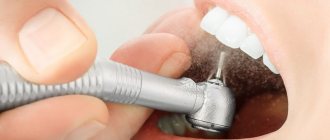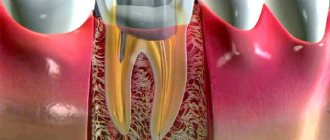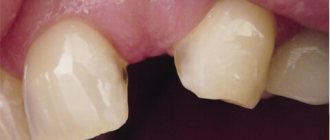Indications for placing a temporary filling
- Treatment of deep caries. After cleansing the tooth cavity from necrotic masses, the dentist places a medicinal solution that helps the dentin strengthen the layer between the pulp chamber and the open cavity.
- Diagnosis of the condition of the tooth with deep caries before installing a permanent filling.
- Acute pulpitis. A temporary intermediate composition is placed while the nerve is removed.
- Periodontitis. To relieve inflammation, an antiseptic or medicinal preparation is placed in the area of the tooth roots, which is then covered with light cement.
- Sanitation of dental canals before filling. The doctor cleans the canals, filling them with a disinfectant solution, then places a temporary filling.
- Prosthetics, restoration. The process of making an artificial crown or orthodontic structure takes several days. To protect against microbes, the open tooth cavity is closed with a temporary filling material.
Stages of placing a temporary filling:
- opening the tooth cavity, removing all affected dentin tissue;
- expansion, cleaning, treatment of dental canals;
- therapeutic stage (depending on the diagnosis, the nerve endings of the pulp are removed, medications are placed in the tooth cavity, and the canals are filled with temporary cement);
- The crown is closed with a temporary filling.
Cost of filling
The cost of filling is not limited to the cost of filling material. The doctor first removes tooth tissue affected by caries, fills the resulting cavity with appropriate material, and gives the restored tooth the correct shape. Typically, the cost of installing a filling is already included in the price of the caries treatment procedure. In economy class clinics this price ranges from one to three thousand rubles, although there are also price lists with prices starting from 500 rubles. Business class dentistry will cure caries and install a light filling for 4,000 rubles, and services in premium clinics and dentistry for VIP patients will cost from 6,000 rubles.
Material of manufacture
Requirements for temporary filling materials:
- no toxic effect on tooth structures (enamel, dentin, pulp) and mucous membranes of the oral cavity;
- safety for human health;
- chemical inertness and high resistance to saliva and aggressive environments (alkalies, acids);
- mechanical strength, wear resistance, ductility;
- lack of galvanization effect;
- maintaining shape and size during hardening;
- good radiopacity.
The choice of material for a temporary filling depends on the clinical case, age, individual characteristics of the body (the presence of allergies to certain substances), as well as how long the patient will wear it.
Types of materials for dental fillings
Dental clinics today use various filling compounds. More information about the names of fillings and materials used can be obtained directly from your doctor. Filling materials are made based on the following components:
- Amalgam. A metal filling compound that is strong and durable. Quite rarely used in practice. The advantages include strength and abrasion resistance. The disadvantages are unaesthetic and the risk of developing allergies. There are contraindications.
- Cement. The main material for chemical fillings. The most commonly used powder is zinc oxide with the addition of silicon and magnesium. The advantages are affordable cost, ease of installation, and reduced risk of developing recurrent caries. The downside is quick erasing and poor aesthetics.
- Plastic. Composite product for durability and reliability. The best option when you don’t know what filling to put on a tooth and have a limited budget. Compositions based on acrylic acids are especially popular. They are distinguished by good durability and the ability to select colors. The downside is the high risk of microscopic pores.
- Photopolymers. Light-curing filling materials are the most popular today. The paste mixture hardens under the influence of ultraviolet light. The advantages are natural shine, strength, aesthetics, minimal toxicity. A light seal made of photopolymer material is practically free of disadvantages.
- Composites. Plastic products with special inorganic fillers. Among them is a gutta-percha filling. It is distinguished by strength, indelibility, and resistance to external factors. Used as a filling material for root canals.
- GIC (glass ionomer cements). High-strength filling material used for fixing crowns. Has excellent adhesion to metal and ceramic products.
More information about glass ionomer and light-based fillings can be obtained directly from your dentist. The choice of filling composition must be approached responsibly and trusted by your attending physician, since the performance of the chewing function will depend on this. At our AlphaDent dental clinic you can get detailed advice on selecting the necessary filling to suit your individual characteristics.
Intermediate filling materials
- A paste based on zinc sulfate and kaolin allows you to restore the crown of the tooth.
- Karyosan has an analgesic and antiseptic effect.
- Vinoxol is an artificial dentin. Withstands chewing load for up to 1-2 months.
- Cement with zinc and eugenol. It is used for antiseptic treatment of tooth tissue and relief of the inflammatory process.
- Glass ionomer cement is used for temporary fixation of the prosthesis.
- One-component polymer materials are pastes with a viscous consistency that harden under the light of a special lamp.
What care do fillings require?
Filled teeth do not require any special care, but we must not forget that you need to brush them, regardless of whether they have fillings or not, at least twice a day and very carefully. Dentists also recommend attending professional oral hygiene procedures at least once every six months. In this case, the hygienist should grind existing fillings and pay special attention to them.
You also need to remember that filling material is still more porous than enamel, so it absorbs pigments from coloring foods and drinks more strongly. That is why, immediately after caries treatment, it is not recommended to eat beets, red berries and similar foods for several days, especially when it comes to the front teeth.
How long does it take to wear a temporary filling?
Depending on the material of manufacture, a temporary filling has different characteristics of strength and tightness and can last from several days to six months.
Average duration of use of a temporary filling:
- 2-3 days, if a drug is placed under the filling that destroys the nerve endings of the pulp;
- 7–10 days while treatment of the inflammatory process with periodontitis or pulpitis continues;
- 2-3 weeks - for the period of manufacture of the orthopedic structure;
- several months in special diagnostic cases (when treating a dental cyst, restoring dentin after deep caries).
It is necessary to strictly adhere to the timing of wearing temporary fillings. If the time period is extended, its integrity and sealing may be compromised, which will negatively affect the health of the tooth. Thus, arsenic-based paste, if not removed after 2-3 days, begins to penetrate the dentin through the tubules, destroying bone tissue.
How long a temporary filling can be worn is decided by the attending physician, depending on the diagnosis and the chosen treatment method.
Removing a temporary filling is a mandatory procedure before placing a permanent filling. After removal of the temporary composite, antiseptic treatment of the root canals and dental cavity is carried out. Next, a permanent filling is installed.
Precautionary measures
In order not to bitterly regret the time spent in the dentist’s office, after installing a temporary filling, it is highly advisable to follow the following simple rules:
- When brushing your teeth, especially if the filling has been installed for a fairly long period of time, use a brush with soft bristles. Otherwise, oral care is carried out as usual: brushing 2 times a day, you can use rinses.
- Try not to chew on the affected side of your mouth, and temporarily avoid sticky toffees, chewing gum, hard nuts, bones and candy. Do not put pressure on the tooth while testing the strength of the filling.
- Within 1 day after installation, it is not advisable to eat beets, drink coffee, tea, or red wine, as the filling may become stained.
- Toothache will be relieved by rinsing with chamomile and sage decoctions, an aqueous solution with sea salt and soda. As for painkillers, it is better to consult a doctor. Aspirin should be avoided: it is ineffective against toothache, and in large quantities it harms the stomach.
- The most pressing question that arises after a temporary filling has been installed is: when can you eat? Modern reflective fillings harden almost instantly, meaning you can eat food within 20 minutes. But this is theoretical, but in practice it is better to clarify this point with the dentist. In most cases, you can safely eat and drink 2-3 hours after filling.
It is important to remember that the highest quality temporary filling is not a suitable replacement for a permanent one, so you should not delay your visit to the dental office.
Problems that arise when installing a temporary filling
Painful sensations can be caused by an incompletely destroyed nerve, infection under the filling, or the development of inflammation.
The filling falls out or crumbles. If you do not immediately consult a dentist, the treatment will have to begin again with re-sanitation of the canals, treating them with antiseptics to stop the development of infection.
An unpleasant taste in the mouth often indicates depressurization of the temporary coating, when the medicine from the tooth begins to leak into the oral cavity.
Darkening of the filling, swelling or redness of the gums may be signs of an allergic reaction to a component of the filling material.
Light-curing filling: advantages and installation features
A more accurate name for this dental composite material is photopolymer filling. The prefix “photo-” indicates that special light is needed to cure the filling, and polymers are composite materials.
A light filling gives the dentist the opportunity to accurately reproduce a full-fledged tooth, because, unlike a cement filling, it hardens only under the influence of a lamp. However, it is worth remembering that over time, even the best light-curing filling will darken or become noticeable at the border with the enamel. Therefore, and also because it may fall out at the end of its service life, the structure requires timely replacement, on average, once every five years. As for installing fillings on the front teeth, modern dentistry suggests using ceramic inlays instead. They are better, imitate natural tissues, last longer and are practically invisible on the teeth even after several years.
What determines the maximum wearing period?
The maximum wearing period is determined by the dentist individually.
The maximum period of wearing a temporary filling depends on several factors:
- method of treatment;
- type of filling material used;
- means for filling into the tooth cavity.
The drilled hole may not reflect the full picture of the disease or may require further placement of medication. A temporary filling in this context serves as an auxiliary diagnostic function.
Short-term operation of the insert requires high-quality installation of the filling mass with hermetically sealed closure of the cavity in the tooth. This will ensure reliable fixation of the embedded drug and prevent food particles from penetrating inside. Previously, to suppress the sensitivity of the nerve, arsenic was inserted into the cleaned tooth hole. At the same time, the filling could not be kept for long and had to be replaced after 72 hours.
Modern dentists prefer to use other drugs, which increases the period of wearing a filling insert from 5 days to 3 weeks . If the patient needs long-term treatment, then reflective material is used as medical cement (lasts from 3 to 6 months).
Correct positioning
Often complex treatment of pulpitis or periodontitis cannot be performed in a single session:
- During the initial treatment, the dentist usually diagnoses the diseased tooth and opens it with drilling.
- The tooth is processed, a temporary expansion of the root canal occurs to remove pus or damaged areas of the tooth.
- After this, cleansing, removal of nerves and other manipulations during treatment occur.
- A temporary filling is placed over the exposed tooth to prevent germs from entering the open cavity.
Such cleaning of the canals may be required more than once, so the doctor must wait until the patient is pain-free before placing a long-term filling. Once the toothpaste has hardened, you should handle it with care as it is usually quite fragile.
In the first hours, it is not recommended to eat food or chew gum. During treatment, switch to a toothbrush with very soft bristles.








